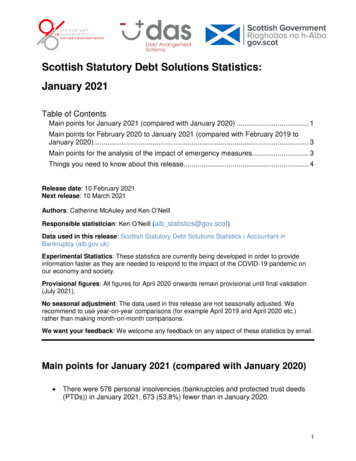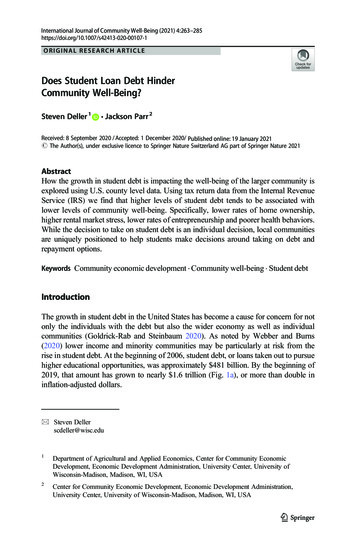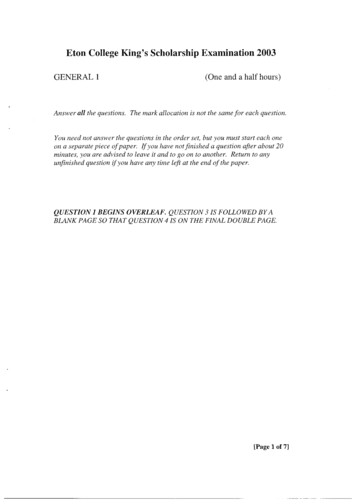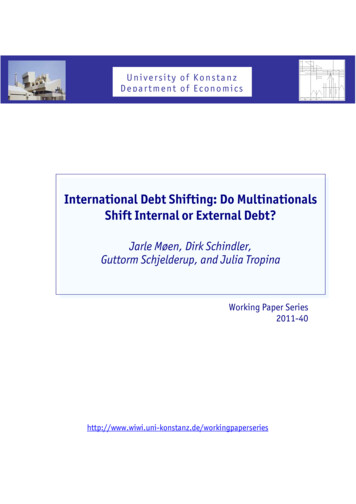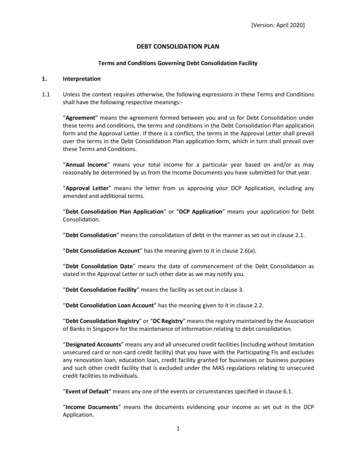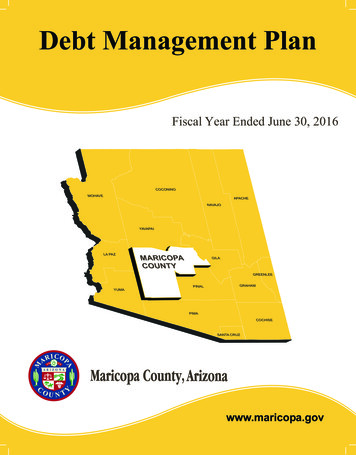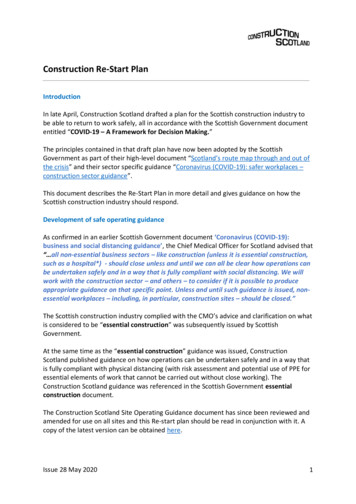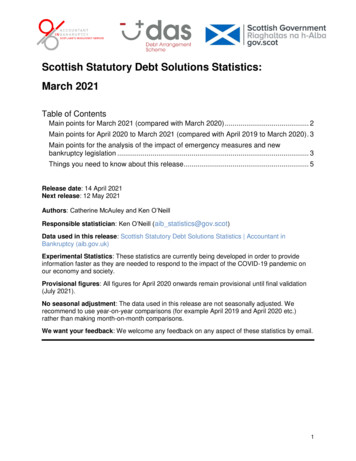
Transcription
Scottish Statutory Debt Solutions Statistics:March 2021Table of ContentsMain points for March 2021 (compared with March 2020) . 2Main points for April 2020 to March 2021 (compared with April 2019 to March 2020) . 3Main points for the analysis of the impact of emergency measures and newbankruptcy legislation . 3Things you need to know about this release . 5Release date: 14 April 2021Next release: 12 May 2021Authors: Catherine McAuley and Ken O’NeillResponsible statistician: Ken O’Neill (aib statistics@gov.scot)Data used in this release: Scottish Statutory Debt Solutions Statistics Accountant inBankruptcy (aib.gov.uk)Experimental Statistics: These statistics are currently being developed in order to provideinformation faster as they are needed to respond to the impact of the COVID-19 pandemic onour economy and society.Provisional figures: All figures for April 2020 onwards remain provisional until final validation(July 2021).No seasonal adjustment: The data used in this release are not seasonally adjusted. Werecommend to use year-on-year comparisons (for example April 2019 and April 2020 etc.)rather than making month-on-month comparisons.We want your feedback: We welcome any feedback on any aspect of these statistics by email.1
Main points for March 2021 (compared with March 2020) There were 688 personal insolvencies (bankruptcies and protected trust deeds(PTDs)) in March 2021, 369 (34.9%) fewer than in March 2020. Bankruptcies decreased by 37.2% in March 2021 when compared with March2020.(It is important to note that these provisional results will not be finalised until finalvalidation. The late reporting of creditor petitions, in particular, may lead todifferences between first provisional estimates and actual finalised figures.) PTDs decreased by 33.6% over the same period. There were 432 approved Debt Payment Programmes (DPPs) under the DebtArrangement Scheme in March 2021 compared with 336 in March 2020, anincrease of 28.6%.2
Main points for April 2020 to March 2021 (compared withApril 2019 to March 2020) All main points within this section are presented on a 12-month rolling basis. There were 7,600 personal insolvencies in the 12 months to March 2021(inclusive), 5,891 (43.7%) fewer than in the previous 12 months. Bankruptcies decreased by 50.8% in the 12 months to March 2021 whencompared with the previous 12 months. PTDs decreased by 39.8% over the same period. There were 3,676 approved DPPs under the Debt Arrangement Scheme in the12 months to March 2021 compared with 3,130 for the previous 12 months, anincrease of 17.4%.Main points for the analysis of the impact of emergencymeasures and new bankruptcy legislationThe introduction of new provisions on the statutory moratorium are part ofemergency measures brought in by the Coronavirus (Scotland) Act 2020: As at 31 March 2021, 1,977 applications for moratoria had been granted underthe new powers. There were 298 applications for moratoria granted in March 2021 under the newlegislation, 217 more than in March 2020 under the previous provisions. There were 1,980 applications for moratoria granted in the 12 months to March2021 (inclusive) compared with 1,093 for the previous 12 months, an increase of81.2%.A revised bankruptcy application fee structure has been introduced, initially throughthe Coronavirus (Scotland) (No. 2) Act 2020 and placed on permanent footingthrough the Bankruptcy (Miscellaneous Amendments) (Scotland) Regulations 2021: In the period between 27 May 2020 and 31 March 2021 a total of 1,971bankruptcy awards were made following applications submitted to AiB, allthrough the revised fee structure. Of this total, 1,533 (77.8%) applicants were notrequired to pay any fee at all.Summary of Emergency Legislation – COVID-19 emergency legislation Accountantin Bankruptcy (aib.gov.uk)3
Summary of Bankruptcy Regulations 2021 – Bankruptcy changes provide help for themost financially vulnerable Accountant in Bankruptcy (aib.gov.uk)4
Things you need to know about this releaseThis monthly release contains the latest statistics on statutory debt solutions inScotland. The statistics are compiled by Accountant in Bankruptcy (AiB), an executiveagency of the Scottish Government, and are derived from AiB administrative records.Following end of year validation, estimates for April 2019 to March 2020 are final.Estimates for April 2020 to March 2021 are provisional until final figures are expected tobe published in Summer 2021.Non-statutory debt solutions, where debtors make their own arrangements withcreditors or enter informal debt management plans with a debt management firm, arenot included in these statistics.These statistics presented in this release have been classed as ‘experimental’ - seebelow for more information on Experimental Statistics. The work programme hasfocused on user needs, completeness of the data collected and quality assuranceprocesses.Why this release is being published?As the demand increases for statistics and data to measure the impact of the COVID-19pandemic, Accountant in Bankruptcy has had to change its data gathering and releasepractices, focussing efforts on priority analysis and statistics. In line with guidance fromthe Office for Statistics Regulation, on Friday 20 March 2020, the production andpublication of the main quarterly Scottish Insolvency Statistics were temporarilysuspended until further notice. This action was necessary due to an urgent shift ofresource within Scottish Government to help manage immediate issues arising from theCOVID-19 pandemic.However, AiB ensured that we continued to produce vital data and statistics needed toresponse to the impact of this COVID-19 pandemic on our economy and society.Therefore, the monthly publication series titled “Scottish Statutory Debt Solutions” wascreated for this purpose.Since January 2021, AiB is currently publishing the quarterly publication series. Pleasenote this publication series will be renamed as “Scottish Statutory Debt SolutionsStatistics”. Please see the following link for further information on upcoming officialstatistics publications:Upcoming official and experimental statistics publications: October 2020 Accountant inBankruptcy (aib.gov.uk)Meanwhile, Accountant in Bankruptcy (AiB) produces data and statistics to supportdecision-makers in Scotland and our trusted, impartial information is more importantnow than ever.5
The COVID-19 outbreak is a significant challenge for the UK and we are working toensure that AiB continues to produce vital data and statistics needed to respond to theimpact of this pandemic on our economy and society.This means we will need to ensure that information is provided faster, and we need tochange how we produce and publish in order to ensure we provide the informationnecessary as the situation unfolds.These changes to our work could affect the quality of some of our statistics, such aslower accuracy, or it could mean there is less detail available due to lack of resources.Decisions will be made on a case by case basis, taking into account what information iscurrently relevant given the situation, with the three pillars of the Code of Practice forStatistics (Trustworthiness, Quality and Value) guiding our decisions. Giving everyoneaccess to statistics at the same time remains a fundamental principle of the Code, butwhere this cannot be maintained we will be open and transparent about this and anyother potential effects on our statistics.What are “Experimental Statistics”?Experimental statistics are a type of official statistics that are undergoing development.This is the first time Accountant in Bankruptcy (AiB) has produced monthly statistics onstatutory debt solutions where the experimental statistics label has been used with theaim for compliance with the Code of Practice for Official Statistics.Experimental statistics and the Code of Practice: Defined in the Code of Practice forOfficial Statistics - ctice/ - as ‘statisticsundergoing evaluation and published to involve users and stakeholders in theirdevelopment’. The Code promotes and supports the release of experimental statistics toinvolve users in their development at an early stage and achieve continuousimprovement in statistical processes.It is possible, however, that the statistics will not be fully compliant in all areas due totheir nature as ‘data being developed’.QualityRelevanceRelevance is the degree to which statistics meet the current and potential needs ofuser.The statistics produced by AiB are the most complete record of the number of statutorydebt solutions and statutory moratorium on diligence. The statistics presented here donot include non-statutory debt solutions. This is where debtors make their ownarrangements with creditors or enter informal debt management plans with a debt6
management firm. The demand for statutory debt solutions should be seen within thecontext of the overall debt solution market (both statutory and non-statutory solutions).This demand will be affected by changes in the legislative and regulative environment.For example, changes to regulatory procedures operated by the Financial ConductAuthority could affect the supply of non-statutory solutions and in turn the demand forstatutory debt solutions.Key users of AiB’s debt solution statistics are: AiB itself, which has policy responsibilityfor statutory debt solutions in Scotland; the insolvency profession; debt advice agencies;media organisations; academics; creditors and the general public.AccuracyAccuracy is the closeness between an estimated result and the (unknown) true value.All formal insolvency procedures entered into by a company, a partnership or anindividual are required by law to be reported to the appropriate body, so the statisticsshould be a complete record of statutory insolvency in Scotland.The number of statutory debt solutions and statutory moratorium on diligence are basedon the date of the order, agreement of the insolvency procedure or the approval date,not on the date it was registered on the administrative recording system. This does nothave any implication for cases processed within AiB.However, the published number of creditor petitions will be influenced by, for example,the late reporting of creditor petitions court orders, which may lead to missing data.Under the current revision policy, figures on the number of creditor petitions are revisedmonthly to account for late reporting or missing cases.Data validation processes are in place to identify and resolve erroneous data inputs andduplication of cases or when extracting data from the administrative systems, to makesure that returns cover all debt solutions, and to check the accuracy and consistencywithin tables and between related tables.Timeliness and punctualityTimeliness refers to the time gap between the publication date and the reference periodfor the statistics.Punctuality is the time lag between the actual and planned dates of publication for thestatistics.The Scottish Statutory Debt Solutions Statistics (monthly series) are published on thesecond Wednesday of the month following the end of the month being reported on. Thispublication date allows receipt of all the data inputs and sufficient time for qualityassurance of the data extracts, tabulating records and completing the compilation of thestatistical release. This means there is a maximum of two weeks lag between the end ofthe month and the publication of the monthly Scottish Statutory Debt SolutionsStatistics. The exact publication date will be pre-announced through a 12-month release7
calendar, giving a specific release date at least four weeks in advance wherepracticable – Official statistics: forthcoming publications - gov.scot (www.gov.scot)Accessibility and clarityAccessibility is the ease with which users can access the statistics and data. It is alsoabout the format in which data is available and the availability of supporting information.Clarity refers to the quality and sufficiency of the commentary, illustrations,accompanying advice and technical details.The monthly Scottish Statutory Debt Solutions Statistics are available free of charge tothe end user on the AiB website. They are published as a PDF via the website. Theaccompanying tables are also published in the Excel format. Contact details can befound at the beginning of our publication report for any specific data requests.It is important to ensure that statistics are presented in a clear, unambiguous way thatsupports and promotes use by all types of users. To this end, we have adopted the useof plain language as much as possible. The main findings are presented using a seriesof text and charts. Technical terms, acronyms and definitions are defined and explainedwhen this is appropriate. These approaches would ensure that the statistics can beused effectively.However, AiB do want readers and users’ feedback on any aspect of these statistics,and encourage them to get in touch with us. Contact details can be found at thebeginning of our publication report.ComparabilityComparability is the degree to which statistics can be compared over time, region oranother domain.Statutory debt solutions statistics can be compared between different type of debtsolutions. They can be used to identify trends over time.However, changes in legislation and policy may affect the extent to which comparisonscan be made over time for individual data series. Such change might cause breaks intime series so that statistics from before and after the change are not comparable.Where such changes are known, they have been highlighted in the commentary and inthe general background notes along with the implications for use made clear.CoherenceCoherence is the degree to which the statistical processes that generate two or moreoutputs use the same concepts and harmonised methods.Overall, the monthly and quarterly Scottish Statutory Debt Solutions Statistics are thedefinitive source of statistics for statutory debt solutions in Scotland. The InsolvencyService includes figures from both the monthly and quarterly Scottish Statutory DebtSolutions Statistics publications in their official statistics releases on individualinsolvencies - Individual Insolvency Statistics Releases - GOV.UK (www.gov.uk).8
It is important to note that the operational, policy and legislative differences in all nationsof UK, and users should be mindful of this caveat when making comparisons with otherparts of the UK.AiB publishes year end totals of the annual quarterly statistics in its annual corporatereport, that are not currently in official statistics publications. These numbers may differslightly to those reported throughout the year, but the monthly and quarterly statisticsare subsequently revised to match. In these annual corporate reports, statistics by localauthority areas are included and this is achieved by matching the postcode with theStandard Geography Code Register: statistics.gov.scot: Standard Geography CodeRegister. This Register contains the standard statistical blocks which are Output Areas,Data Zones and Intermediate Zones, and these blocks are derived from Scotland’s2011 Census geographies. By adoption the standard geography code, this ensuresgeographical harmonisation and coherence, and thus the data to be consistent overtime between local authority areas (and possibly other geographical dimensions) withinScotland. Note, when producing statistics by local authority areas, numbers may differslightly as postcodes of debtors cannot always be assigned, where this occurs thesedifferences will be highlighted.Overall, the monthly and quarterly official statistics are the definitive source of statisticsfor statutory debt solutions in Scotland.Can figures in this release be compared with published officialstatistics in the quarterly Scottish Statutory Debt Solutions Statisticspublications?Please note that, prior to January 2021, the quarterly publication series was named“Scottish Insolvency Statistics”.Figures for April 2020 to February 2021 presented in this release remain provisionaluntil final validation in July 2021. Therefore, caution is needed when interpreting thesefigures.With this caveat in mind, both sets of quarterly and annual figures can be compared.Detailed time-series data for the latest Official Statistics publication can be found in thefollowing link:Quarterly Scottish Statutory Debt Solution Statistics publications9
Non-statutory debt solutions, where debtors make their own arrangements with creditors or enter informal debt management plans with a debt management firm, are not included in these statistics. These statistics presented in this release have been classed as 'experimental' - see below for more information on Experimental Statistics.
